
A span of nearly two years is presented today, from late 1947 into 1949. Featured performers include Elmer Fudd, Yosemite Sam, Mighty Mouse and Oil Can Harry, Goofy, amd the Terrytoons’ lion, among others, with Bugs Bunny, Porky Pig, and Blackie the black sheep along as spectators or masters of ceremonies.
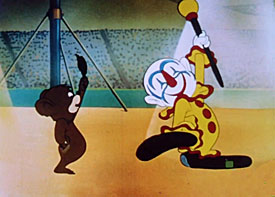 The Circus Comes To Clown (Paramount/Famous, Screen Song, 12/26/47 – I. Sparber, dir.) – Though there had already been several Technicolor (or other color processes) comebacks for Max Fleischer’s “bouncing ball” sing-alongs produced by Famous under the heading of “Noveltoons”, this was the first to revive the series banner of Max’s original works. Titles are presented on custom art cards in circus decor, featuring tents, clowns, etc. Action begins with a grand entrance parade. A furry hat worn by a clown drum-major leaps off his head, to reveal a bear cub who joins in the march. The “Pedaling Foursome” consists of four animals on a tandem bike – a mouse, elephant, goose, and – far in the rear by way of a long extension – a skunk. A politically-incorrect twist on the Siamese Twins gag from the 1930’s has a pair of junior black twins, with one eating watermelon, and the other spitting out the seeds. A conga-dancing line of elephants harkens back to Fleischer’s “Terror on the Midway”. As the show begins, a pig performs a daring jump through a blazing hoop, emerging out the other side as a smoked ham. Flipper the seal will not play his set of horns, holding out much in the manner of Donald Duck’s horn-tooting seal in “Mickey’s Circus”, but with a modern-day added twist, as the seal holds up a sign to his trainer making reference to frequently-striking current head of the musician’s union – “Petrillo says, two fish.” A lion tamer attempts to arouse two sleeping jungle beasts into action by snapping a whip, then firing a pistol. The lions open one eye each at the pistol shot, then produce from within their paws a pair of machine guns, peppering the trainer with shots offscreen, as a loud thud indicates his downfall, and the lions go back to sleep. The star performer is a wolf “man on the flying trapeze”. In his only cameo role in another series, Blackie the black sheep is seen in a box-seat balcony with a sheep girlfriend (possibly remembering Krazy Kat’s “The Trapeze Artist”), as the girl watches the performer in wide-eyed wonderment, an x-ray view of her heart displaying the organ also performing trapeze swings from side to side. Much as in the Krazy Kat, the wolf swings down to the balcony, stealing a kiss from the girl, with such suction that he pulls her out of her seat, taking her to sit upon his extended legs and swing with him on the trapeze, while Blackie begins the familiar phrases of “The Man On The Flying Trapeze” as the subject for sing-along, his tear transforming into the bouncing ball. When the song concludes, the girl is nowhere to be seen, but the wolf is still performing, swinging from a trapeze by his teeth. Below, Blackie takes careful aim with a shotgun, and fires at him. The blast disintegrates the performer, leaving only his dentures clinging to the trapeze bar. A cross-dissolve takes us to the gates of heaven, where the wolf’s spirit ascends into the clouds by way of a series of cloudy trapeze bars, then enters the pearly gates, which close behind him with the words “The End” written upon them.
The Circus Comes To Clown (Paramount/Famous, Screen Song, 12/26/47 – I. Sparber, dir.) – Though there had already been several Technicolor (or other color processes) comebacks for Max Fleischer’s “bouncing ball” sing-alongs produced by Famous under the heading of “Noveltoons”, this was the first to revive the series banner of Max’s original works. Titles are presented on custom art cards in circus decor, featuring tents, clowns, etc. Action begins with a grand entrance parade. A furry hat worn by a clown drum-major leaps off his head, to reveal a bear cub who joins in the march. The “Pedaling Foursome” consists of four animals on a tandem bike – a mouse, elephant, goose, and – far in the rear by way of a long extension – a skunk. A politically-incorrect twist on the Siamese Twins gag from the 1930’s has a pair of junior black twins, with one eating watermelon, and the other spitting out the seeds. A conga-dancing line of elephants harkens back to Fleischer’s “Terror on the Midway”. As the show begins, a pig performs a daring jump through a blazing hoop, emerging out the other side as a smoked ham. Flipper the seal will not play his set of horns, holding out much in the manner of Donald Duck’s horn-tooting seal in “Mickey’s Circus”, but with a modern-day added twist, as the seal holds up a sign to his trainer making reference to frequently-striking current head of the musician’s union – “Petrillo says, two fish.” A lion tamer attempts to arouse two sleeping jungle beasts into action by snapping a whip, then firing a pistol. The lions open one eye each at the pistol shot, then produce from within their paws a pair of machine guns, peppering the trainer with shots offscreen, as a loud thud indicates his downfall, and the lions go back to sleep. The star performer is a wolf “man on the flying trapeze”. In his only cameo role in another series, Blackie the black sheep is seen in a box-seat balcony with a sheep girlfriend (possibly remembering Krazy Kat’s “The Trapeze Artist”), as the girl watches the performer in wide-eyed wonderment, an x-ray view of her heart displaying the organ also performing trapeze swings from side to side. Much as in the Krazy Kat, the wolf swings down to the balcony, stealing a kiss from the girl, with such suction that he pulls her out of her seat, taking her to sit upon his extended legs and swing with him on the trapeze, while Blackie begins the familiar phrases of “The Man On The Flying Trapeze” as the subject for sing-along, his tear transforming into the bouncing ball. When the song concludes, the girl is nowhere to be seen, but the wolf is still performing, swinging from a trapeze by his teeth. Below, Blackie takes careful aim with a shotgun, and fires at him. The blast disintegrates the performer, leaving only his dentures clinging to the trapeze bar. A cross-dissolve takes us to the gates of heaven, where the wolf’s spirit ascends into the clouds by way of a series of cloudy trapeze bars, then enters the pearly gates, which close behind him with the words “The End” written upon them.
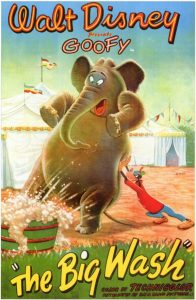 The Big Wash (Disney/RKO, Goofy, 2/6/48 – Clyde Geronimi, dir.) – One of a short string of Goofy titles made without the direction of Jack Kinney, likely while Jack was sidetracked with the feature production of “The Wind In the Willows” segment of “Ichabod and Mr. Toad”. While Geronimi’s pacing is slow and methodic, his animation of the Goof is meticulously smooth and classy, with a great deal of subtle expressiveness. Goofy returns to the old stomping grounds of his most frequent voice-provider (Pinto Colvig), who himself in his early years performed as a circus clown. He is employed to care for the circus elephant – who seems to be the only one on the lot, named Dolores. (The same elephant, with the same introductory song based upon her name used in this film, would make one later reappearance, tended by Donald Duck in a zoo in 1953’s “Working For Peanuts”.) As dawn breaks, Dolores wants breakfast. She arouses a sleeping Goofy by ripping the top off of his small circus wagon home with her trink, and trumpeting like a live alarm clock into Goofy’s ear. Oblivious to the destruction of the wagon, Goofy marches through its still-standing door, despite the fact the door s not mounted to anything and quickly falls away. Dolores engages in a game of “guess which hand” to procure a peanut from Goofy – but both hands are mischievously empty. Dolores runs a thorough body-frisk of Goofy with her trunk, finally grabbing up the Goof by the ankles and shaking him vigorously to empty out all contents of his circus coat and trousers. After gently cracking open a peanut retrieved from the pile under her hoof, the next event on Dolores’s daily agenda is a morning bath. But this is an event she dreads, and even dipping one hoof into the soapy bubbling water of a pail sends her into shudders and a racing stampede away. Goofy pursues her with a long hose connected to a plumbing pipe, but the hose length runs out before Goofy can corner her, snapping the Goof back, and tying him up in knots below a fountain created by the hose’s nozzle.
The Big Wash (Disney/RKO, Goofy, 2/6/48 – Clyde Geronimi, dir.) – One of a short string of Goofy titles made without the direction of Jack Kinney, likely while Jack was sidetracked with the feature production of “The Wind In the Willows” segment of “Ichabod and Mr. Toad”. While Geronimi’s pacing is slow and methodic, his animation of the Goof is meticulously smooth and classy, with a great deal of subtle expressiveness. Goofy returns to the old stomping grounds of his most frequent voice-provider (Pinto Colvig), who himself in his early years performed as a circus clown. He is employed to care for the circus elephant – who seems to be the only one on the lot, named Dolores. (The same elephant, with the same introductory song based upon her name used in this film, would make one later reappearance, tended by Donald Duck in a zoo in 1953’s “Working For Peanuts”.) As dawn breaks, Dolores wants breakfast. She arouses a sleeping Goofy by ripping the top off of his small circus wagon home with her trink, and trumpeting like a live alarm clock into Goofy’s ear. Oblivious to the destruction of the wagon, Goofy marches through its still-standing door, despite the fact the door s not mounted to anything and quickly falls away. Dolores engages in a game of “guess which hand” to procure a peanut from Goofy – but both hands are mischievously empty. Dolores runs a thorough body-frisk of Goofy with her trunk, finally grabbing up the Goof by the ankles and shaking him vigorously to empty out all contents of his circus coat and trousers. After gently cracking open a peanut retrieved from the pile under her hoof, the next event on Dolores’s daily agenda is a morning bath. But this is an event she dreads, and even dipping one hoof into the soapy bubbling water of a pail sends her into shudders and a racing stampede away. Goofy pursues her with a long hose connected to a plumbing pipe, but the hose length runs out before Goofy can corner her, snapping the Goof back, and tying him up in knots below a fountain created by the hose’s nozzle.
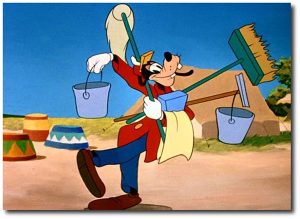 An odd transition takes place from a fade-out to a jump cut showing the exterior of a clown tent, as Dolores emerges, with a full face of pasty make-up, bulb nose, and old man’s beard. (Though no known print depicts anything missing here from the film’s original release, was the jump cut merely a director’s choice, or indication of some sequence edited before release that failed to pass the censorship board?) As Dolores fakes a hobble upon a crooked cane, the Goof passes, dragging the hose nozzle along in the pocket of his pants. “Good morning, Sir”, says Goofy, completely fooled by the disguise. Dolores spots the trailing hose, and quickly moves over to the water valve it is connected to, turning on the flow full force. Goofy’s trousers begin to balloon as he walks, then his shirt, and he looks down at his roly-poly figure with the usual reaction line, “Sump’in wrong here.” The water continues to inflate Goofy to a complete sphere, then explodes his outfit, leaving him drenched and somewhat tattered. Dolores runs for cover, making a turn around a circus tent. At the other side of the tent, Goofy appears, looking high and low for his elusive charge. Just next to him, a circus wagon begins to pull away, exiting the frame. Behind it, compactly compressed to match the dimensions of the wagon, is the standing Dolores. Goof finally manages to lay hand on her, dragging the huge mammoth back to the wash pail by the ear as if she were an overgrown “bad boy” child. Hammering stakes around her into the ground, Goofy manacles Dolores’s feet to make her stay put. He begins to mount a ladder up her side. Dolores provides a detour, by lifting the ladder from the ground with her trunk as Goofy climbs. Goofy steps off the last rung into mid-air, them falls, landing headfirst in one of his wash buckets, while Dolores shakes her head in comic “tisk tisk” fashion at Goofy’s downfall. However, an Achillies’ heel is revealed as to Dolores, as Goofy’s box of “Soapy Suds” powdered soap is dispensed like a cloud into the air. Dolores begins a series of allergic sneezes (an idea retreaded from an earlier Geronimi Pluto short, “Pantry Pirate”), the first of which launches Goofy like a dart headfirst through a fence on which is plastered a circus poster, leaving the Goof’s body to appear to be protruding from a lion’s mouth. Goofy sets up a scaffold on Dolores’s side and begins the bath with a long brush, but Dolores begins to sneeze again. Goofy rushes to try to block the sneeze at Dolores’s trunk, but she ejects a forceful blast, which hollows out a crater in the ground below Goofy, and leaves the Goof perched in mid-air atop a soap bubble, which pops, depositing him in the crater as Goofy gives his signature yell. Goof again mounts Dolores, scrubbing a complete coat of soap all over her back. Another sneeze develops, and Dolores blasts herself out of her bonds and enurely out of frame, leaving Goofy standing atop the coat of suds, until it dwindles and pops down to nothing, depositing Goofy upon the ground. Goofy looks around, spotting a small tent bulging with the dimensions of a shuddering elephant inside. Before Goofy can enter the tent, another sneeze blasts Dolores backwards as if jet-propelled, flattening Goofy. A further sneeze jets Dolores back in the opposite direction, colliding her with Goofy, and smashing both of them into the circus’s water wagon, leaving them sitting in a muddy mess created by the spilled water. Dolores rises, revealing Goofy underneath, covered in mud from head to toe. Dolores turns the tables, producing a shower of water from her trunk, and ending the cartoon by becoming bath-giver rather than receiver, as the chuckling Goofy gets cleaned up whether he wants to or not.
An odd transition takes place from a fade-out to a jump cut showing the exterior of a clown tent, as Dolores emerges, with a full face of pasty make-up, bulb nose, and old man’s beard. (Though no known print depicts anything missing here from the film’s original release, was the jump cut merely a director’s choice, or indication of some sequence edited before release that failed to pass the censorship board?) As Dolores fakes a hobble upon a crooked cane, the Goof passes, dragging the hose nozzle along in the pocket of his pants. “Good morning, Sir”, says Goofy, completely fooled by the disguise. Dolores spots the trailing hose, and quickly moves over to the water valve it is connected to, turning on the flow full force. Goofy’s trousers begin to balloon as he walks, then his shirt, and he looks down at his roly-poly figure with the usual reaction line, “Sump’in wrong here.” The water continues to inflate Goofy to a complete sphere, then explodes his outfit, leaving him drenched and somewhat tattered. Dolores runs for cover, making a turn around a circus tent. At the other side of the tent, Goofy appears, looking high and low for his elusive charge. Just next to him, a circus wagon begins to pull away, exiting the frame. Behind it, compactly compressed to match the dimensions of the wagon, is the standing Dolores. Goof finally manages to lay hand on her, dragging the huge mammoth back to the wash pail by the ear as if she were an overgrown “bad boy” child. Hammering stakes around her into the ground, Goofy manacles Dolores’s feet to make her stay put. He begins to mount a ladder up her side. Dolores provides a detour, by lifting the ladder from the ground with her trunk as Goofy climbs. Goofy steps off the last rung into mid-air, them falls, landing headfirst in one of his wash buckets, while Dolores shakes her head in comic “tisk tisk” fashion at Goofy’s downfall. However, an Achillies’ heel is revealed as to Dolores, as Goofy’s box of “Soapy Suds” powdered soap is dispensed like a cloud into the air. Dolores begins a series of allergic sneezes (an idea retreaded from an earlier Geronimi Pluto short, “Pantry Pirate”), the first of which launches Goofy like a dart headfirst through a fence on which is plastered a circus poster, leaving the Goof’s body to appear to be protruding from a lion’s mouth. Goofy sets up a scaffold on Dolores’s side and begins the bath with a long brush, but Dolores begins to sneeze again. Goofy rushes to try to block the sneeze at Dolores’s trunk, but she ejects a forceful blast, which hollows out a crater in the ground below Goofy, and leaves the Goof perched in mid-air atop a soap bubble, which pops, depositing him in the crater as Goofy gives his signature yell. Goof again mounts Dolores, scrubbing a complete coat of soap all over her back. Another sneeze develops, and Dolores blasts herself out of her bonds and enurely out of frame, leaving Goofy standing atop the coat of suds, until it dwindles and pops down to nothing, depositing Goofy upon the ground. Goofy looks around, spotting a small tent bulging with the dimensions of a shuddering elephant inside. Before Goofy can enter the tent, another sneeze blasts Dolores backwards as if jet-propelled, flattening Goofy. A further sneeze jets Dolores back in the opposite direction, colliding her with Goofy, and smashing both of them into the circus’s water wagon, leaving them sitting in a muddy mess created by the spilled water. Dolores rises, revealing Goofy underneath, covered in mud from head to toe. Dolores turns the tables, producing a shower of water from her trunk, and ending the cartoon by becoming bath-giver rather than receiver, as the chuckling Goofy gets cleaned up whether he wants to or not.
The Mysterious Stranger (Terrytoons/Fox, Mighty Mouse, disputed dates 8/1/48 or 12/21/48 – Connie Rasinski, dir.) – Standard Oil Can Harry/Pearl Pureheart fare, with a couple of twists. Pearl is here referred to as Little Nell, trapeze star of the “little circus that travels hither and yon, making little children happy”. The opening of the film is told mostly in stills, like a children’s storybook, in repetition prose resembling the add-on meter of “The House That Jack Built”. Oil Can Harry seeks her hand, but Nell refuses, devoting her life to the little circus. Harry appears at her dressing wagon, but has the door slammed so hard in his face, the doorknob comes loose, and penetrates a large round hole through his teeth. Add the plot twist – watching all of these developments is a derby-hatted, trenchcoat-clad figure whose face remains entirely hidden except for eyes in the shadows of the outfit, known only as “The Mysterious Stranger”.
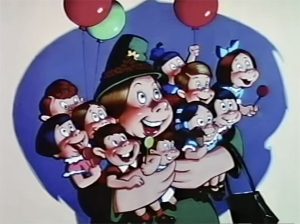 At the night’s performance, Nell performs an exceptionally-graceful solo trapeze act, soaring from perch to perch, in fluid animation which I might venture a hunch may again be the work of resident expert at portraying the female form, Carlo Vinci. Oil Can climbs to one of the trapezes, and swings out after Nell, who climbs onto a platform on the opposite side of the tent to keep just out of reach of Harry’s clutches. As Harry swings back and forth by his heels, the Mysterious Stranger appears on the platform from which Harry began, armed with a large mallet. Harry swings backwards, and a clunk is heard. Harry’s trapeze returns into camera view, carrying only Harry’s empty shoes. Nell resumes the act, while Harry tries to reach her again, by climbing the bean of light emitted from one of the spotlights, as if it were a solid cylinder. When Harry is halfway up to Nell, the Stranger appears again, and switches off the spotlight. Harry again plummets to the ground, with such force that the shock waves briefly balloon-out the entire circus tent. Angry, Harry produces a pistol, and declares that the Stranger has interfered with him for the last time. The stranger suddenly hurls away hat and overcoat, revealing himself as – Mighty Mouse. (Mighty would remember his disguise, using it one other time in his later career.) Harry shows his cowardice, nervously suggesting that maybe they should talk this over, and Harry’s gun falls apart piece by piece. Desperate, Harry runs for the Human Cannonball cannon, and fires a cannonball into Mighty’s chest. Mighty is thrust backwards, colliding with the pole on which Nell is perched. The pole and Nell topple down, with Harry catching Nell in his hat. Remainder of the film is a typical chase, taking some silly turns such as pursuit with pistols on Merry-Go-Round horses, and as escape of Harry in a hot air balloon, Harry stupidly forgetting that Mighty can fly too, such that the escape vehicle merely confines Harry’s efforts to fight back. It of course permits Nell to faint, fall out of the balloon’s gondola, and have Mighty perform his typical catch of the falling damsel in mid-air, returning her for a flight around the circus tent to the audience’s cheers, for the fade out.
At the night’s performance, Nell performs an exceptionally-graceful solo trapeze act, soaring from perch to perch, in fluid animation which I might venture a hunch may again be the work of resident expert at portraying the female form, Carlo Vinci. Oil Can climbs to one of the trapezes, and swings out after Nell, who climbs onto a platform on the opposite side of the tent to keep just out of reach of Harry’s clutches. As Harry swings back and forth by his heels, the Mysterious Stranger appears on the platform from which Harry began, armed with a large mallet. Harry swings backwards, and a clunk is heard. Harry’s trapeze returns into camera view, carrying only Harry’s empty shoes. Nell resumes the act, while Harry tries to reach her again, by climbing the bean of light emitted from one of the spotlights, as if it were a solid cylinder. When Harry is halfway up to Nell, the Stranger appears again, and switches off the spotlight. Harry again plummets to the ground, with such force that the shock waves briefly balloon-out the entire circus tent. Angry, Harry produces a pistol, and declares that the Stranger has interfered with him for the last time. The stranger suddenly hurls away hat and overcoat, revealing himself as – Mighty Mouse. (Mighty would remember his disguise, using it one other time in his later career.) Harry shows his cowardice, nervously suggesting that maybe they should talk this over, and Harry’s gun falls apart piece by piece. Desperate, Harry runs for the Human Cannonball cannon, and fires a cannonball into Mighty’s chest. Mighty is thrust backwards, colliding with the pole on which Nell is perched. The pole and Nell topple down, with Harry catching Nell in his hat. Remainder of the film is a typical chase, taking some silly turns such as pursuit with pistols on Merry-Go-Round horses, and as escape of Harry in a hot air balloon, Harry stupidly forgetting that Mighty can fly too, such that the escape vehicle merely confines Harry’s efforts to fight back. It of course permits Nell to faint, fall out of the balloon’s gondola, and have Mighty perform his typical catch of the falling damsel in mid-air, returning her for a flight around the circus tent to the audience’s cheers, for the fade out.
 A Horsefly Fleas (Warner, 12/18/48 – Robert McKimson, dir.), receives an honorable mention. The film is a cowboy-and-Indians style reworking of Bob Clampett’s “An Itch In Time”, with a pioneer flea and a horsefly mount (dispossessed from a milk wagon horse when the milk companies start delivering by truck) seeking to stake out a new home in the high mountain territory of a dog’s butt. They are pursued throughout the picture by a tribe of Indian fleas who already inhabit the hairs of the dog’s posterior. In the middle of all the chasing, a line of miniature shadows is seen across the living room carpet. It is a string of tiny circus-style wagons, following a small sign in the rug pointing to “Winter quarters” – namely, the reclining dog. The wagons roll up the dog’s hind leg, eventually arousing him with a start. A further surprise travels up another of the dog’s front legs, as the flea and horsefly, followed by the tribe of whooping Indian fleas, also mount the canine. The dog bends over for a closer look at what is going on. An inspection under a magnifying glass reveals that the wagons have erected a full big top and midway, not nominally a circus, but billed on a sign outside as a Wild West Show. Nevertheless, the dog reacts with surprising enthusiasm, gathering around him three of four bags of popcorn, as many balloons, and a large cone of cotton candy, remarking to the camera, “Oh, boy. I haven’t seen a circus since I was a little pup.” Inside the miniature tent, the flea and horsefly circle around the arena, with the Indian fleas continuing to pursue at a short distance behind. The flea delivers curtain line to the audience: “As long as they’re gonna chase me anyway, I might as well get paid for it.”
A Horsefly Fleas (Warner, 12/18/48 – Robert McKimson, dir.), receives an honorable mention. The film is a cowboy-and-Indians style reworking of Bob Clampett’s “An Itch In Time”, with a pioneer flea and a horsefly mount (dispossessed from a milk wagon horse when the milk companies start delivering by truck) seeking to stake out a new home in the high mountain territory of a dog’s butt. They are pursued throughout the picture by a tribe of Indian fleas who already inhabit the hairs of the dog’s posterior. In the middle of all the chasing, a line of miniature shadows is seen across the living room carpet. It is a string of tiny circus-style wagons, following a small sign in the rug pointing to “Winter quarters” – namely, the reclining dog. The wagons roll up the dog’s hind leg, eventually arousing him with a start. A further surprise travels up another of the dog’s front legs, as the flea and horsefly, followed by the tribe of whooping Indian fleas, also mount the canine. The dog bends over for a closer look at what is going on. An inspection under a magnifying glass reveals that the wagons have erected a full big top and midway, not nominally a circus, but billed on a sign outside as a Wild West Show. Nevertheless, the dog reacts with surprising enthusiasm, gathering around him three of four bags of popcorn, as many balloons, and a large cone of cotton candy, remarking to the camera, “Oh, boy. I haven’t seen a circus since I was a little pup.” Inside the miniature tent, the flea and horsefly circle around the arena, with the Indian fleas continuing to pursue at a short distance behind. The flea delivers curtain line to the audience: “As long as they’re gonna chase me anyway, I might as well get paid for it.”
As previously mentioned, Friz Freleng, without casting Bugs Bunny into a direct circus role, was prone to find the most unlikely venues for Bugs to engage in circus-style acts. Within one-half year of 1949, Freleng would premiere two more instances of such conduct for Bugs, and one for Porky Pig to boot. Hare Do (Warner, Bugs Bunny, 1/15/49) is nearly the same plot as “Stage Door Cartoon”, simply updating the theater into which Bugs and Elmer run to one that shows movies with an occasional stage act, rather than one that presents stage acts with an occasional movie. This latter effort, however, is even more fine-tuned as to character animation, dialogue, and timing than the first, with some sterling gags, and remains a Bugs-Elmer classic.
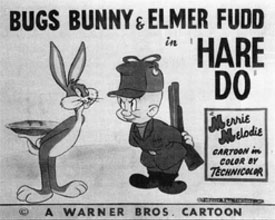 Bugs begins the day dealing with an army-surplus “wabbit detector” purchased by Elmer, leading him astray by way of a verbal game of “warmer” and “colder” into walking off a cliff. The chase begins, and Bugs thumbs a ride from a passing motorist to make an escape. “Ya gotta get up early in the morning to outsmart this rabbit”, chuckles Bugs to himself from the back seat. Then the driver of the auto is revealed – as Elmer! “I got up at quarter of five”, he smiles. Bugs jumps out of the car as it passes the subject movie house, and gets in cheap, as the admission prices include Rabbits at 10 cents. Many memorable bits ensue inside, including a vending machine that just happens to dispense cellophane-wrapped carrots with change included, and a classic diversion as Bugs takes control of a switch alerting the audience to “Intermission” and “Curtain”, using the patrons to run down Elmer repeatedly in a human stampede. (This gag was so good, it was robbed by Terrytoons for Heckle and Jeckle’s “Off To the Opera”.) Finally, Bugs intercepts Elmer in the darkened theater aisle, by impersonating an usher. With a small flashlight, he leads Elmer through interminable darkness, claiming “All seats down front.” After the longest walk, Bugs announces “Here’s your seat”, though Elmer complains he can’t see a thing. Suddenly, the darkness is broken by a pair of spotlights. One is upon Bugs, standing on stage in a Ringmaster’s uniform. The other points to an astronomically-high platform near the ceiling of the oversized theater, perched at the top of a 45-degree angled high wire leading from platform to stage. Atop the platform sits Elmer, upon a unicycle, with a pair of dark sunglasses placed over his eyes, still complaining about being unable to see a thing. Bugs, in standard Ringmaster spiel, announces that his partner will descend the wire on the unicycle, to land directly into the jaws of a vicious man-eating lion (who appears next to Bugs, smacking its lips in anticipation). How did Bugs find all these props, outfit, and the lion? Don’t ask. “Oh boy, this ought to be good. I wish I could see it”, says Elmer, as his unicycle begins to roll swiftly down the wire. In trademark Freleng manner, action is depicted through camera diversion and sound effect, as Bugs’ eyes follow the offscreen descent of the unicycle to the stage, and a sound of a thud and a smacking of lips denotes Elmer’s swallowing. Bugs races over to the smiling, satisfied lion, and pries open its jaws, while the audience applauds wildly. From within the throat of the lion’s open mouth, the voice of Elmer is heard. “Gee, I wonder if he made it?”. Bugs responds, half to Elmer, and half to the audience: “Yup, he made it”, then clamps the lion’s jaws shut again, for the iris out.
Bugs begins the day dealing with an army-surplus “wabbit detector” purchased by Elmer, leading him astray by way of a verbal game of “warmer” and “colder” into walking off a cliff. The chase begins, and Bugs thumbs a ride from a passing motorist to make an escape. “Ya gotta get up early in the morning to outsmart this rabbit”, chuckles Bugs to himself from the back seat. Then the driver of the auto is revealed – as Elmer! “I got up at quarter of five”, he smiles. Bugs jumps out of the car as it passes the subject movie house, and gets in cheap, as the admission prices include Rabbits at 10 cents. Many memorable bits ensue inside, including a vending machine that just happens to dispense cellophane-wrapped carrots with change included, and a classic diversion as Bugs takes control of a switch alerting the audience to “Intermission” and “Curtain”, using the patrons to run down Elmer repeatedly in a human stampede. (This gag was so good, it was robbed by Terrytoons for Heckle and Jeckle’s “Off To the Opera”.) Finally, Bugs intercepts Elmer in the darkened theater aisle, by impersonating an usher. With a small flashlight, he leads Elmer through interminable darkness, claiming “All seats down front.” After the longest walk, Bugs announces “Here’s your seat”, though Elmer complains he can’t see a thing. Suddenly, the darkness is broken by a pair of spotlights. One is upon Bugs, standing on stage in a Ringmaster’s uniform. The other points to an astronomically-high platform near the ceiling of the oversized theater, perched at the top of a 45-degree angled high wire leading from platform to stage. Atop the platform sits Elmer, upon a unicycle, with a pair of dark sunglasses placed over his eyes, still complaining about being unable to see a thing. Bugs, in standard Ringmaster spiel, announces that his partner will descend the wire on the unicycle, to land directly into the jaws of a vicious man-eating lion (who appears next to Bugs, smacking its lips in anticipation). How did Bugs find all these props, outfit, and the lion? Don’t ask. “Oh boy, this ought to be good. I wish I could see it”, says Elmer, as his unicycle begins to roll swiftly down the wire. In trademark Freleng manner, action is depicted through camera diversion and sound effect, as Bugs’ eyes follow the offscreen descent of the unicycle to the stage, and a sound of a thud and a smacking of lips denotes Elmer’s swallowing. Bugs races over to the smiling, satisfied lion, and pries open its jaws, while the audience applauds wildly. From within the throat of the lion’s open mouth, the voice of Elmer is heard. “Gee, I wonder if he made it?”. Bugs responds, half to Elmer, and half to the audience: “Yup, he made it”, then clamps the lion’s jaws shut again, for the iris out.
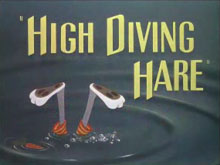 Freleng returns to Bugs and Elmer’s original act from “Stage Door Cartoon”, now as a vehicle for Yosemite Sam, building a whole cartoon around it in High Diving Hare (4/30/49). As if it wasn’t outrageous enough to stage a precarious high-dive on a vaudeville stage in the first film, Freleng now purports to move the act into the confines of the stage of a wild-west saloon. (Cartoons had this “interior bigger than exterior” structure problem licked long before Harry Potter and friends used a roomy traveling tent to visit the Quidditch World Cup.) Bugs Bunny is the barker and organizer of the traveling show appearing for one night only at the saloon, featuring as its star performer Fearless Freep in the high-dive. Yosemite Sam turns out to be a big fan of Freep, and “splurges” by buying a whole mess of tickets. Sitting in the front row, Sam, along with many other patrons, become impatient for the show to start, Sam firing his pistols, and demanding “Bring on Freep.” It is hard to tell if this is the old West or modern West, as Bugs receives a telegram at the stage door, stating “Delayed by storm. Arrive tomorrow. Signed Fearless Freep.” Bugs emerges on stage with the bad news, but Sam won’t take no for an answer. Someone’s going to take that dive, and Sam insists “That someone’s a-gonna be you.”
Freleng returns to Bugs and Elmer’s original act from “Stage Door Cartoon”, now as a vehicle for Yosemite Sam, building a whole cartoon around it in High Diving Hare (4/30/49). As if it wasn’t outrageous enough to stage a precarious high-dive on a vaudeville stage in the first film, Freleng now purports to move the act into the confines of the stage of a wild-west saloon. (Cartoons had this “interior bigger than exterior” structure problem licked long before Harry Potter and friends used a roomy traveling tent to visit the Quidditch World Cup.) Bugs Bunny is the barker and organizer of the traveling show appearing for one night only at the saloon, featuring as its star performer Fearless Freep in the high-dive. Yosemite Sam turns out to be a big fan of Freep, and “splurges” by buying a whole mess of tickets. Sitting in the front row, Sam, along with many other patrons, become impatient for the show to start, Sam firing his pistols, and demanding “Bring on Freep.” It is hard to tell if this is the old West or modern West, as Bugs receives a telegram at the stage door, stating “Delayed by storm. Arrive tomorrow. Signed Fearless Freep.” Bugs emerges on stage with the bad news, but Sam won’t take no for an answer. Someone’s going to take that dive, and Sam insists “That someone’s a-gonna be you.”
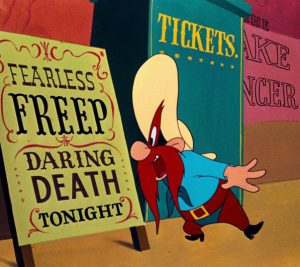 A notable continuity error has Bugs, followed by gun-toting Sam, climbing the ladder 500 feet to the diving platform, first from the back side of the ladder away from the audience, then on the ladder’s front-side (where it would be impossible to climb onto the platform, which is mounted directly to the ladder, right in their way). Yosemite pushes Bugs out onto a long diving board extending from the platform, but Bugs manages to keep from going over the edge by hanging onto the board with his toes. Yosemite keeps his revolvers trained on Bugs, and demands he quit stalling. Bugs counters with a request that Sam close his eyes while Bugs slips into his bathing trunks. Sam obliges, and, though Bugs slips into an old-fashioned gay-‘90’s style bathing suit, he takes the added liberty of delivering a sidewise kick to the diving board, pivoting the board upon its central supporting nail 180 degrees. Yosemite, who was standing on the rear portion of the board, is suddenly pivoted to a position extending off the platform, over the water tank below. (Disney studios would swipe this diving-board spin gag for Donald Duck’s “Trailer Horn” in 1950.) When Sam opens his eyes, he watches Bugs dive off his end of the board – but in fact, Bugs merely drops a few inches onto the base of the diving platform, whistles to provide sound-effect of falling through the air, then yells “SPLASH”, tossing up to Yosemite’s view a few drops of water from a water glass. “By Gar, the critter went and done it”, remarks an impressed Sam, as he turns to leave – not realizing he is stepping off the board onto thin air. Bugs miraculously zooms down the ladder faster than gravity, occupying Sam’s front-row seat, stating “I don’t wanna miss this.” Sam plunges into the wooden water tank, whose side planks fall away, revealing Yosemite circling around in the water within, the water inexplicably maintaining its shape as if still held in place by the tank walls.
A notable continuity error has Bugs, followed by gun-toting Sam, climbing the ladder 500 feet to the diving platform, first from the back side of the ladder away from the audience, then on the ladder’s front-side (where it would be impossible to climb onto the platform, which is mounted directly to the ladder, right in their way). Yosemite pushes Bugs out onto a long diving board extending from the platform, but Bugs manages to keep from going over the edge by hanging onto the board with his toes. Yosemite keeps his revolvers trained on Bugs, and demands he quit stalling. Bugs counters with a request that Sam close his eyes while Bugs slips into his bathing trunks. Sam obliges, and, though Bugs slips into an old-fashioned gay-‘90’s style bathing suit, he takes the added liberty of delivering a sidewise kick to the diving board, pivoting the board upon its central supporting nail 180 degrees. Yosemite, who was standing on the rear portion of the board, is suddenly pivoted to a position extending off the platform, over the water tank below. (Disney studios would swipe this diving-board spin gag for Donald Duck’s “Trailer Horn” in 1950.) When Sam opens his eyes, he watches Bugs dive off his end of the board – but in fact, Bugs merely drops a few inches onto the base of the diving platform, whistles to provide sound-effect of falling through the air, then yells “SPLASH”, tossing up to Yosemite’s view a few drops of water from a water glass. “By Gar, the critter went and done it”, remarks an impressed Sam, as he turns to leave – not realizing he is stepping off the board onto thin air. Bugs miraculously zooms down the ladder faster than gravity, occupying Sam’s front-row seat, stating “I don’t wanna miss this.” Sam plunges into the wooden water tank, whose side planks fall away, revealing Yosemite circling around in the water within, the water inexplicably maintaining its shape as if still held in place by the tank walls.
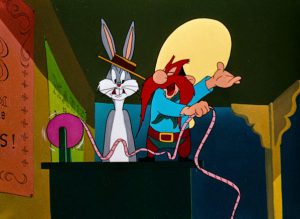 Bugs takes the stage, attempting to announce the next act, but is again met by the pistol-packin’, drenched Sam, who still maintains that he’s going to see Bugs dive. Up they climb again. Not learning from past mistakes, Sam again stands on the rear end of the diving board. Bugs takes several bounces on his end of the board to the “One for the money” rhyme, but completes the verse with a forceful jump that vibrates the rear end of the board with enough power to launch Sam off the platform like a catapult. Bugs suddenly remembers that he forgot to fill the tank with water. From nowhere, he produces a pail of the stuff, and hurls it downward in the direction of Sam. Sam looks up to see the trail of water gaining on him and beginning to pass. Sam gestures with his hand as if to encourage the water to fall faster, takes a time-out to assume a kneeling position and say a prayer, then shifts position to hop onto the trailing end of the water, stomping on it to force it down faster still. (All of this breaking every aerodynamic rule, as Sam and the water would obviously fall at the same speed.) The water hits the tank first, in the nick of time. Little good it does Yosemite, who misses the tank entirely, smashing a hole right through the stage.
Bugs takes the stage, attempting to announce the next act, but is again met by the pistol-packin’, drenched Sam, who still maintains that he’s going to see Bugs dive. Up they climb again. Not learning from past mistakes, Sam again stands on the rear end of the diving board. Bugs takes several bounces on his end of the board to the “One for the money” rhyme, but completes the verse with a forceful jump that vibrates the rear end of the board with enough power to launch Sam off the platform like a catapult. Bugs suddenly remembers that he forgot to fill the tank with water. From nowhere, he produces a pail of the stuff, and hurls it downward in the direction of Sam. Sam looks up to see the trail of water gaining on him and beginning to pass. Sam gestures with his hand as if to encourage the water to fall faster, takes a time-out to assume a kneeling position and say a prayer, then shifts position to hop onto the trailing end of the water, stomping on it to force it down faster still. (All of this breaking every aerodynamic rule, as Sam and the water would obviously fall at the same speed.) The water hits the tank first, in the nick of time. Little good it does Yosemite, who misses the tank entirely, smashing a hole right through the stage.
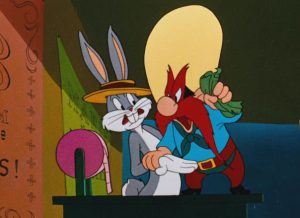 Shall we try it again? Getting used to things, Bugs merely shrugs his shoulders before the third climb. A carefully-placed camera shot shows Sam stepping out onto the diving board, but finding no one on its end. “Where’s the critter at?” queries Sam, until he hears carrot-chomping on the opposite side of the board. In a longer shot, we see Bugs, standing erect, but on the opposite side of the board opposing Sam’s feet. Sam addresses him: “Great horny toads! What’re ya’ doin’ down there upside downy?” “I’m not upside-down Doc”, replies Bugs, “You are.” We find that we have been looking at things through the eyes of an upside-down camera, and Yosemite falls – up – into the tank. Sam climbs again, chewing out Bugs with a string of cussing-style insults. Bugs repeats a bit previously used in “Bugs Bunny Rides Again”, accusing Sam of uttering “fighting words”, and challenging him to step across a line. Of course, the line is drawn at the very end of the diving board. Sam steps, with the usual result – except this time, Sam reverses his fall just long enough to rise back to Bugs, pause, and say “I hate you”, before plunging. Sam returns to the platform again, but finds Bugs has erected a wooden door between himself and Sam on the diving board. “Open up that door”, shouts Sam, trying to break it down. Sam pauses, however, addressing the audience with “You notice I didn’t say ‘Richard’?” (Reference to a pop song hit of the day “Open the Door, Richard”, performed by many black performers.) Sam rushes the door, but Bugs flings it open on cue, allowing Sam to fall once again. Bugs provides a further diversion on the next try, posing as an Indian scout, and directing Sam to a short cut to head the rabbit off at the pass – right off the end of the board again. Freleng next again uses unseen action to portray events, having Sam seen climbing up the ladder two more times, then passing back through the frame in free-fall each time, without explaining how Bugs did it. Sam climbs up a final time at double-speed, and then we hear the off-screen sound of sawing wood. We cut to the platform, where Bugs stands, well tied-up in rope at the end of the diving board, while Yosemite stoops near the mid-point of the board, sawing through it. “Let’s see ya’ get out of this one”, chortles Sam. We do, as the platform, not Bugs’ end of the board, snaps off, and collapses to the ground, taking Sam with it. Still standing on the board in mid-air, Bugs utters a line which would become a well-used staple of Warner’s gag book in future cartoons: “I know this defies the law of gravity, but you see, I never studied law.”
Shall we try it again? Getting used to things, Bugs merely shrugs his shoulders before the third climb. A carefully-placed camera shot shows Sam stepping out onto the diving board, but finding no one on its end. “Where’s the critter at?” queries Sam, until he hears carrot-chomping on the opposite side of the board. In a longer shot, we see Bugs, standing erect, but on the opposite side of the board opposing Sam’s feet. Sam addresses him: “Great horny toads! What’re ya’ doin’ down there upside downy?” “I’m not upside-down Doc”, replies Bugs, “You are.” We find that we have been looking at things through the eyes of an upside-down camera, and Yosemite falls – up – into the tank. Sam climbs again, chewing out Bugs with a string of cussing-style insults. Bugs repeats a bit previously used in “Bugs Bunny Rides Again”, accusing Sam of uttering “fighting words”, and challenging him to step across a line. Of course, the line is drawn at the very end of the diving board. Sam steps, with the usual result – except this time, Sam reverses his fall just long enough to rise back to Bugs, pause, and say “I hate you”, before plunging. Sam returns to the platform again, but finds Bugs has erected a wooden door between himself and Sam on the diving board. “Open up that door”, shouts Sam, trying to break it down. Sam pauses, however, addressing the audience with “You notice I didn’t say ‘Richard’?” (Reference to a pop song hit of the day “Open the Door, Richard”, performed by many black performers.) Sam rushes the door, but Bugs flings it open on cue, allowing Sam to fall once again. Bugs provides a further diversion on the next try, posing as an Indian scout, and directing Sam to a short cut to head the rabbit off at the pass – right off the end of the board again. Freleng next again uses unseen action to portray events, having Sam seen climbing up the ladder two more times, then passing back through the frame in free-fall each time, without explaining how Bugs did it. Sam climbs up a final time at double-speed, and then we hear the off-screen sound of sawing wood. We cut to the platform, where Bugs stands, well tied-up in rope at the end of the diving board, while Yosemite stoops near the mid-point of the board, sawing through it. “Let’s see ya’ get out of this one”, chortles Sam. We do, as the platform, not Bugs’ end of the board, snaps off, and collapses to the ground, taking Sam with it. Still standing on the board in mid-air, Bugs utters a line which would become a well-used staple of Warner’s gag book in future cartoons: “I know this defies the law of gravity, but you see, I never studied law.”
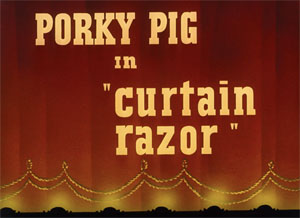 Curtain Razor (Warner, Porky Pig, 5/21/49), is a potpourri of spot gags, as performers of all varieties audition before Porky Pig at the Goode and Korny Talent Agency. Freleng repeats himself with slight variation from the routine performed by Bugs and Elmer in “Stage Door Cartoon”, discussed earlier in these articles, as a high-diving dog rises to 500 feet through an office skylight on a portable diving platform which extends like a telephone extender, then leaps without any water receptacle placed ahead of him. In mid fall, he repats Bugs’ spiel that he will dive not into a tank, but an ordinary drinking glass of water. In this instance, he pulls out the water glass from his pocket, and manages to extend his arm to place it on the floor a split second before his impact, winding up all scrunched-up inside the glass just as Elmer did. Another performer is ringmaster-outfitted Crawford Coo and his performing pigeons. Before opening the cage housing his starring birds, Crawford sets up on a table a small staircase and balancing platform, a miniature tight wire and matching bicycle upon the wire, a high-diving platform and water pool, and several small trapeze swings. He then opens the cage door – to watch all of his birds immediately fly away out the office window. The embarrassed Coo tries to cover by improvising a soft-shoe dance, but quickly disappears down a trap door installed in Porky’s floor. (This entire sequence would be reused again for Bugs’ and Daffy’s 1950’s vaudeville extravaganza, “Show Biz Bugs”, as would a non-circus related finale act about drinking and igniting several high explosives while wearing a devil suit, with the punchline “But I can only do it once.”) A third act is played out before Porky as a large sheepdog enters the room. “Oh, a dog act”, remarks Porky. “Nope. My card”, responds the dog. Porky reviews a business card from the dog, reading “Itch & Scratch – World-Famous Flea Circus.” As the dog blows a whistle, a microscopic set of dots disembark from his back, pitching a series of tiny circus tents, and erecting a miniature Ferris wheel and roller coaster. At another whistle, they fold up shop and return to the dog’s back, and the dog merely shuffles off for an exit.
Curtain Razor (Warner, Porky Pig, 5/21/49), is a potpourri of spot gags, as performers of all varieties audition before Porky Pig at the Goode and Korny Talent Agency. Freleng repeats himself with slight variation from the routine performed by Bugs and Elmer in “Stage Door Cartoon”, discussed earlier in these articles, as a high-diving dog rises to 500 feet through an office skylight on a portable diving platform which extends like a telephone extender, then leaps without any water receptacle placed ahead of him. In mid fall, he repats Bugs’ spiel that he will dive not into a tank, but an ordinary drinking glass of water. In this instance, he pulls out the water glass from his pocket, and manages to extend his arm to place it on the floor a split second before his impact, winding up all scrunched-up inside the glass just as Elmer did. Another performer is ringmaster-outfitted Crawford Coo and his performing pigeons. Before opening the cage housing his starring birds, Crawford sets up on a table a small staircase and balancing platform, a miniature tight wire and matching bicycle upon the wire, a high-diving platform and water pool, and several small trapeze swings. He then opens the cage door – to watch all of his birds immediately fly away out the office window. The embarrassed Coo tries to cover by improvising a soft-shoe dance, but quickly disappears down a trap door installed in Porky’s floor. (This entire sequence would be reused again for Bugs’ and Daffy’s 1950’s vaudeville extravaganza, “Show Biz Bugs”, as would a non-circus related finale act about drinking and igniting several high explosives while wearing a devil suit, with the punchline “But I can only do it once.”) A third act is played out before Porky as a large sheepdog enters the room. “Oh, a dog act”, remarks Porky. “Nope. My card”, responds the dog. Porky reviews a business card from the dog, reading “Itch & Scratch – World-Famous Flea Circus.” As the dog blows a whistle, a microscopic set of dots disembark from his back, pitching a series of tiny circus tents, and erecting a miniature Ferris wheel and roller coaster. At another whistle, they fold up shop and return to the dog’s back, and the dog merely shuffles off for an exit.
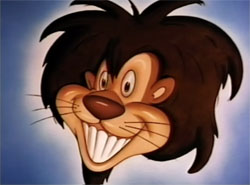 The Lyin’ Lion (Terrytoons/Fox, 8/1/49 – John Foster, dir.) – Looey the Lion (basically the same Bert Lahr-fashioned lion who had frequented Terrytoons since the late 1930’s) is beginning to show his age. Although still a headliner of the circus, a narrator (Tom Morrison) introduces him as someone who was “once” the greatest performer of all time. “Whad’ya mean, ‘Once”?” snaps the lion back, boasting that he’s as great as he ever was, and tonight’s performance will prove it. After a short grand entrance parade (again reusing animation of the elephant beating two drums with his tail from “Circus Days”), a ringmaster introduces Looey’s balancing act. Looey enters, and begins climbing atop the ringmaster’s head. Looey takes some awkward steps and slips upon the ringmaster’s scalp and nose, as the Ringmaster under his breath remarks to Looey, “You old fool. Why don’t you give up?” “I can’t help it if your bald head is slippery”, wise-cracks Looey in response. Looey finally reaches a position where he is balanced upon his tail atop the Ringmaster’s dome, and the two of them extend their arms to shoot off small fireworks for a finale. Then Looey slips, flattening the Ringmaster. Angry, the Ringmaster takes a few swipes at Looey, missing, but then lands a well-placed kick into Looey’s rear. The crowd begins laughing uproariously, while Looey grumpily calls back. “What’s so funny?” The Ringmaster sees opportunity from the laughter, and informs Looey that effective immediately, his act will be changed to that of a circus clown. Looey refuses, his pride hurt, and responds, “I’ll quit first.” As Looey exits the tent, the Ringmaster confidently asides to the audience, “He’ll be back. The sawdust is in his blood.”
The Lyin’ Lion (Terrytoons/Fox, 8/1/49 – John Foster, dir.) – Looey the Lion (basically the same Bert Lahr-fashioned lion who had frequented Terrytoons since the late 1930’s) is beginning to show his age. Although still a headliner of the circus, a narrator (Tom Morrison) introduces him as someone who was “once” the greatest performer of all time. “Whad’ya mean, ‘Once”?” snaps the lion back, boasting that he’s as great as he ever was, and tonight’s performance will prove it. After a short grand entrance parade (again reusing animation of the elephant beating two drums with his tail from “Circus Days”), a ringmaster introduces Looey’s balancing act. Looey enters, and begins climbing atop the ringmaster’s head. Looey takes some awkward steps and slips upon the ringmaster’s scalp and nose, as the Ringmaster under his breath remarks to Looey, “You old fool. Why don’t you give up?” “I can’t help it if your bald head is slippery”, wise-cracks Looey in response. Looey finally reaches a position where he is balanced upon his tail atop the Ringmaster’s dome, and the two of them extend their arms to shoot off small fireworks for a finale. Then Looey slips, flattening the Ringmaster. Angry, the Ringmaster takes a few swipes at Looey, missing, but then lands a well-placed kick into Looey’s rear. The crowd begins laughing uproariously, while Looey grumpily calls back. “What’s so funny?” The Ringmaster sees opportunity from the laughter, and informs Looey that effective immediately, his act will be changed to that of a circus clown. Looey refuses, his pride hurt, and responds, “I’ll quit first.” As Looey exits the tent, the Ringmaster confidently asides to the audience, “He’ll be back. The sawdust is in his blood.”
Sure enough, Looey returns, now with the word “Great” crossed out on his dressing wagon, and the word “Clown” chalked in. “It’s only temporary”, insists Looey to the narrator. Looey makes an entrance in clownface, upon a bicycle with loose wobbly wheels and disconnected handlebars. An elephant grabs hold of Looey’s clown hat, stretching the elastic of his chin strap, then lets go, launching Looey straight into the Ringmaster, who is compressed by the impact into his top hat. “Well, what do ya’ expect with a screwy ol’ bicycle like that?”, protests Looey. But the Ringmaster will have no excuses. “You’re through”, he declares. Looey gets the boot, but vows he is not through yet.
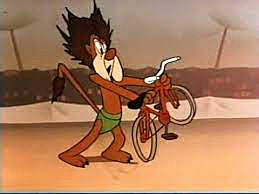 For weeks, off the circus grounds, Looey secretly practices, with one of the monkeys from the circus troupe acting as an assistant, perfecting a new act. Beginning upon a rope only a few inches above ground, Looey attempts to ride a bicycle across a tight wire. Despite initial falls seen in montage, the wire is eventually raised to a daring height, and Looey succeeds in performing a somersault upon the bike and landing back safely upon the wire. He is ready. That night, he slips into the arena while the show is in progress. The Ringmaster quickly spots him in the shadows, and exits the spotlight to attempt to eject the intruder. Looey pedals away quickly, but is tripped up by a teeter-totter board, he and the bike landing on one end. The Ringmaster jumps onto the other side of the board, hoping to catapult Looey out of the ring, but instead lands upon the board with such force, he inadvertently assists Looey in launching him skyward to a position upon the high wire. There, Looey begins to do his stuff, performing spins, wheelies, and other daring maneuvers, that quickly have the audience alternating between gasps of wonderment and tumultuous cheers. The Ringmaster, however, doesn’t think in terms of promoting the new act as a feature attraction – he just wants the old fool lion out. “Come down! You want to kill yourself?”, he hollers. Scaling the ladder to the high wire platform, the Ringmaster cautiously steps out onto the wire to intervene. Looey begins swaying the wire back and forth as a part of his performance, counterbalancing atop the bike. The ringmaster is dimensionally swept back and forth as he tries to keep balance, in a shot that closely resembles animation of Mickey Mouse from “Mickey’s Circus”, and was no doubt inspired by it.
For weeks, off the circus grounds, Looey secretly practices, with one of the monkeys from the circus troupe acting as an assistant, perfecting a new act. Beginning upon a rope only a few inches above ground, Looey attempts to ride a bicycle across a tight wire. Despite initial falls seen in montage, the wire is eventually raised to a daring height, and Looey succeeds in performing a somersault upon the bike and landing back safely upon the wire. He is ready. That night, he slips into the arena while the show is in progress. The Ringmaster quickly spots him in the shadows, and exits the spotlight to attempt to eject the intruder. Looey pedals away quickly, but is tripped up by a teeter-totter board, he and the bike landing on one end. The Ringmaster jumps onto the other side of the board, hoping to catapult Looey out of the ring, but instead lands upon the board with such force, he inadvertently assists Looey in launching him skyward to a position upon the high wire. There, Looey begins to do his stuff, performing spins, wheelies, and other daring maneuvers, that quickly have the audience alternating between gasps of wonderment and tumultuous cheers. The Ringmaster, however, doesn’t think in terms of promoting the new act as a feature attraction – he just wants the old fool lion out. “Come down! You want to kill yourself?”, he hollers. Scaling the ladder to the high wire platform, the Ringmaster cautiously steps out onto the wire to intervene. Looey begins swaying the wire back and forth as a part of his performance, counterbalancing atop the bike. The ringmaster is dimensionally swept back and forth as he tries to keep balance, in a shot that closely resembles animation of Mickey Mouse from “Mickey’s Circus”, and was no doubt inspired by it.
The ringmaster is forced to cling to the wire on all fours, and Looey rides his bike over the Ringmaster’s back. Looey pivot-turns, now approaching the Ringmaster in no-hands fashion, while standing upon his head atop the bicycle’s seat. The ringmaster gets caught up in the bike’s handlebars, and Looey ejects his passenger by popping a wheelie, and giving the handlebars of the bike a quick rotating spin, tossing the Ringmaster overboard. The Ringmaster manages to safely land in a water tank far below. Then Looey reaches the climax of his act, performing a series of somersaulting leaps into the air with his bike. But fate takes a turn for the worse, as Looey misses on one of his landings, becoming separated from the bike, and plunging toward the arena floor. The Ringmaster seizes his chance, positioning under Looey the human cannonball’s cannon. Looey lands squarely in the cannon muzzle, and the Ringmaster fires. Looey rockets through the tent roof, headed straight for the moon. The narrator concludes, stating that some say Looey hit the moon, others that he is no more – but the Ringmaster knows that old Looey’s spirit still lingers on. This is illustrated within the Ringmaster’s wagon as he sleeps at night, as he is rudely awakened and trembles in terror at the image of the bicycling ghost of Looey entering and exiting through the walls of the wagon. The final shot shows the ghost bicyclist in the sky, going through the twirls and leaps of his act, not only without a net, but without a wire, into the heavens.
We’ll venture into the spiffy ‘50’s, next time.


 Charles Gardner is an animation enthusiast who toils by day as a member of LA Law – but by nights and weekends indulges in classic jazz and ragtime as a performer; and studies classic Hollywood cartoons… maybe a little too much.
Charles Gardner is an animation enthusiast who toils by day as a member of LA Law – but by nights and weekends indulges in classic jazz and ragtime as a performer; and studies classic Hollywood cartoons… maybe a little too much.


































































































































































I wasn’t expecting to see “High Diving Hare” here, but I’m certainly not complaining. It’s one of my all-time favourite Bugs Bunny cartoons, definitely in the top ten. If all of Tedd Pierce’s stories were this strong, Friz never would have fobbed him off on Bob McKimson.
Whatever the reason for that abrupt cut in “The Big Wash”, I’m sure it had something to do with Goofy sticking the nozzle of the hose in his pants. Joe Breen probably thought Goofy was giving himself an enema and enjoying it altogether too much.
On the other hand, that closeup of Blackie’s girlfriend’s sweater in “The Circus Comes to Clown” is pretty risqué for a late ’40s cartoon. Not that I’m complaining about that, either. That sweater girl’s a regular Lamb-a Turner! Hubba hub-BAA!
Jim Tyer was at his best animating chases, fights, and slapstick gags. Closeups of characters reciting dialogue, as “The Lyin’ Lion” amply demonstrates, were not his forte. One minor correction: Connie Rasinski directed that cartoon, not John Foster.
How did Bugs find all these props, outfit, and the lion? In the ACME catalog, naturally!
“Fearless Freep! That’s my boy!”
If they ever do a live-action or hybrid Mighty Mouse, Billy Porter would be an ideal Oil Can Harry, who wears a long dress too.
“Kitsune to saakasu [The Fox and the Circus]” (Kindai Eiga Kyoukai Productions, 1948 — Satoshi Morino, dir.) is the fourth in a series of six black-and-white Japanese cartoons starring an unnamed, conniving fox. In 1957 it was provided with English-language narration and syndicated in the United States as “The Big Top Crime”.
During the night a fox steals the world’s most valuable diamond, paints it to look like an ordinary rock, and hides it in the ground for safekeeping. The next morning, however, the circus comes to town, and while the funny animal roustabouts are setting up the big top they dig up all the rocks in the vicinity, including the stolen diamond, to weigh down the edges of the canvas tent. The fox disguises himself as a circus performer in order to recover his treasure, and hijinks ensue. In the end, the fox finds the diamond at the bottom of a diving tank, but it proves too heavy for him to swim to the surface with; and so the thief is caught red-handed.